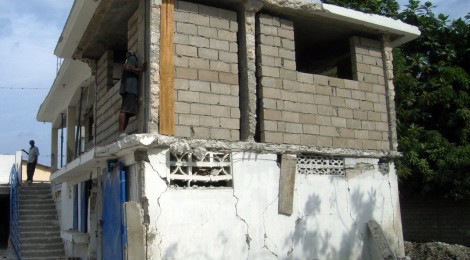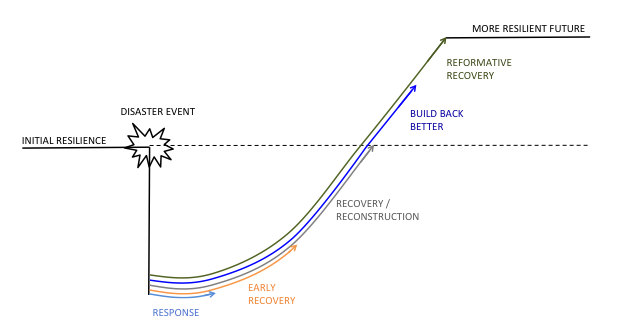
Building Post-Disaster Resilience: A Diagram
I have been working as part of a team (with Anna among others), on an assessment of Haiti’s housing recovery and reconstruction process. Specifically I have been tasked to look at how “disaster risk management” was or was not integrated into reconstruction. I have found this project really interesting, and so I plan to share it, but in digestible pieces surrounding particular ideas.
“Building back better” has been all the rage in the post-disaster reconstruction community. The concept is not particularly novel, but re-branding it with alliteration has made all the difference (it also makes great acronyms like BBB and B3!). The basic idea is that we should not rebuild vulnerability. Unfortunately, the term has pretty much stayed at this level of abstraction: catchy but not particularly descriptive. What does “Building Back Better” mean? Victoria asked similar questions in her post on “what do we mean by recovery?” Specifically she asked “if recovery is a process then what is the intended outcome?” What I am looking at is not outcome as reconstruction in a physical sense (number of buildings reconstructed, etc), but outcome in terms of resilience.
While I was thinking about all this, I started drawing a diagram of how “resilience” progresses through disaster recovery (in an ideal case). This simplified diagram attempts to conceptualize recovery as a process to build resilience, as well as highlights new terminology in the field: “reformative recovery.”

Recovery as a process of resilience building. In this framework, disaster risk reduction in reconstruction means having a steeper trajectory (shorter time) and a higher end-point (more resilience). Diagram by David Lallemant
The humanitarian/reconstruction sector often discusses post-disaster work in terms of “phases,” usually broken down into “response,” “early recovery” and “reconstruction.” This terminology of “phases” is problematic since it implies that these are strictly chronological. In a way, this artificial decomposition of the reconstruction timing has been a self-fulfilling prophecy, since agencies have designed their processes and programs according to this concept (for instance “humanitarian” agencies can often only fund activities linked to so-called “response” and “early recovery”). Hence I will call these “processes” rather than phases, and emphasize through parallel lines that all these activities actually start right after the disaster (or should).
This brings me to the key messages I am attempting to communicate through this diagram:
(1) The response, recovery, reconstruction (and other) processes start at the same time. The attention and funding for each process changes in time, but fundamentally they need to start right after the disaster, at least at the planning level.
(2) The importance of distinguishing these processes is that each is linked to specific activities and goals in terms of resilience:
- Response: the process is one of stabilization, preventing further death or injuries due to the immediate crisis.
- Early Recovery: the goal here is to address the extreme vulnerability following the disaster, such as lack of access to safe shelter, lack of physical security, basic economic security etc.
- Recovery/reconstruction: strictly speaking, recovery and reconstruction means going back to the previous state. Hence this is a restorative process to the original level of resilience.
- Building back better: As mentioned previously, what is rebuilt should be more resilient. Since “building” has a material reality, the term has mostly referred to increasing the resilience of the built environment. It is a classic (and very important!) engineering approach, focused on construction guidelines, material quality etc.
- Reformative recovery: The concept of “reformative recovery” is set in contrast to the traditional “restorative recovery.” The aim of reconstruction has usually been to restore to the previous state. Any improvements from this previous state is usually focused solely on the physical infrastructure (build back better). Reformative recovery by comparison is a process through which new dynamics for resilience are created, often through government and social reform. It is a “new normal” as Victoria mentioned in her post. I stumbled upon the term “Reformative recovery” in this article. I have not seen the term used anywhere else, but I really love it!
(3) Finally, these processes create path-interdependencies (hence the parallel lines). In other words the earlier processes (not so much earlier as those with most funds at the early stages) set the initial direction, therefore creating path dependencies for other activities. This can be very problematic in the absence of common targets. In Haiti following the 2010 earthquake for instance, many of the “temporary” solutions significantly constrained the path for safe permanent reconstruction.
Ultimately this model does not fundamentally change the current framework of thought on reconstruction and resilience, but I hope to give it a bit of a nudge and/or provoke some thinking about the way post-disaster reconstruction can reform the dynamics of risk.









hi! got the link to your blog through shelter geeks on yammer. interested in this topic as well. i’m an architect/ planner working in the philippines.
I think building (back) better actually starts before the disaster..people and governments have to start preparing themselves because there is so much pressure after a disaster to meet humanitarian needs that there is not much time to innovate or introduce new processes/systems or build institutions (all of which are crucial to building better). Creating new dynamics through government and social reform takes time…when this is not done people will revert back to old habits. I have seen it over and over here in the Philippines. Through several cycles of disasters some lessons have been learned, but not enough. One needs to think through building back better and reformative recovery prior to a disaster (similar to what is done with emergency response). I have read somewhere that cities can actually make a ‘post-disaster plan’ in the pre-disaster phase.
Hi Amillah,
Thank you for your comment. I absolutely agree. The effectiveness of post-disaster recovery and reconstruction hinges on pre-disaster preparation. Your comment about building (back) better before the disaster echoes something I heard from Simon Levine of ODI (http://www.odi.org.uk/about/staff/727-simon-levine). He said “reconstruction starts now,” referring specifically to Kathmandu and other cities that have not yet experienced “their” disaster. I cannot say exactly what he meant by this but I interpret it along similar lines as your comment. There is a need to build systems that are less vulnerable to disaster impacts, and build institutions that can effectively respond to and manage large-scale recovery and reconstruction needs. You are correct that some cities are preparing “post-disaster plans.” Here for instance is a great initiative by the San Francisco Planning and Urban Research association (http://www.spur.org/initiative/resilient-city). Finally, I’ll just add a quick Eisenhower quote: “plans are nothing; planning is everything.” I think this is particularly true for the development of post-disaster plans.
Also, I would love to know more about this “shelter geeks” group you mentioned.
Amillah,
I forgot to mention that if you don’t know of them already you should look up the work conducted by EMI (http://www.emi-megacities.org/). They have been working on “risk-sensitive urban development planning” in Metro Manila for some time now (and numerous other places). Very interesting work.
Love this post! Diagrams are a great way to expose whether we see the same things when we lie back and think of resilience… I have loads of questions but you don’t have to answer them. If you could draw lines for Haiti, what would they look like? And what would the diagram look like if the lines started in 1804? Also, more generally do you think there is a window after a disaster when things change faster and then peter out (ie an “n” rather than a “u” shaped curve? How would the money have to flow to really get this u-shaped curve? And is this a smooth line or are there leaps and steps in post-disaster processes? Finally, who/what is the resilient group of people or system? Are different people experiencing these processes in different ways? Are there winners and losers?